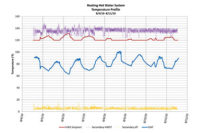Whether it’s new construction commissioning or existing building retro-commissioning, “commissioning” is about entire systems and their performance. Almost universally, owners’ project requirements include “effectiveness” criteria as well as “efficiency” criteria. It’s not good enough that systems provide owners’ desired temperatures, humidities, pressure relationships, air quality, etc. The systems need to do that energy efficiently.
Trend analysis, either from a direct digital control system or from portable data loggers, is a valuable commissioning tool. However, as with most tools, skill and experience are required to realize the most benefit from trend analysis. One of the subtleties of trend analysis is selecting meaningful points for analysis and comparing them side-by-side.
Figure 1 illustrates a very simple single-zone heating, cooling, humidification, and dehumidification system with minimum outside air for a below-grade art storage vault.
Its performance requirements included maintaining a constant 70°F space temperature while keeping space relative humidities between 45-55% rh. We are going to look only at the temperature control element for the purposes of this column. If temperature control (system effectiveness) were one’s only interest, a seemingly obvious trend graph would be the space temperature over a 10-day period as shown in Figure 2. Based on this graph, we could have informed the owner that the system is performing beautifully (very effectively) and moved on to the next system.
However, Figure 2 did not provide any information about efficiency, which is trickier to determine through trend analysis. As with most systems, this AHU did not have energy submeters installed. Therefore, we needed to evaluate efficiency based on other available clues (data points) as illustrated in Figure 3.
Figure 3 painted a very intriguing picture of discharge air temperature being higher than the mixed air temperature while the chilled water valve modulated between 35-40% open (when not dehumidifying). The hot water valve was commanded fully closed (except when reheating for dehumidification) and yet there was a heat source raising the air temperature so much that chilled water was needed to keep the space temperature at set point. The mystery heat source was not in the space because the space temperature was maintained at 70° with an average 70° discharge air temperature.
This trend data led us to a leaking-past heating control valve. Although it was commanded fully closed, the valve was passing hot water through the heating coil, requiring the chilled water valve to compensate. This was not affecting space conditions (i.e., the owner had no complaints about system effectiveness), but the simultaneous heating and cooling was unnecessarily wasting energy at the rate of $4,400/year.






